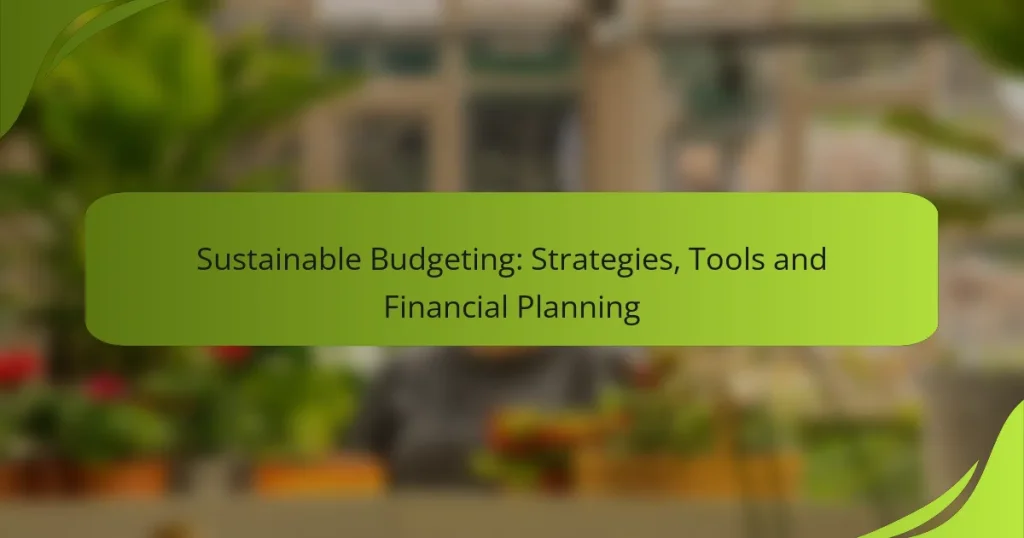Sustainable budgeting is a strategic approach that aligns financial planning with long-term goals while minimizing waste. By utilizing effective methods and tools, individuals and organizations can manage resources efficiently, ensuring that their spending reflects priorities and promotes sustainability. This practice not only enhances financial health but also encourages responsible spending that supports environmental and social objectives.
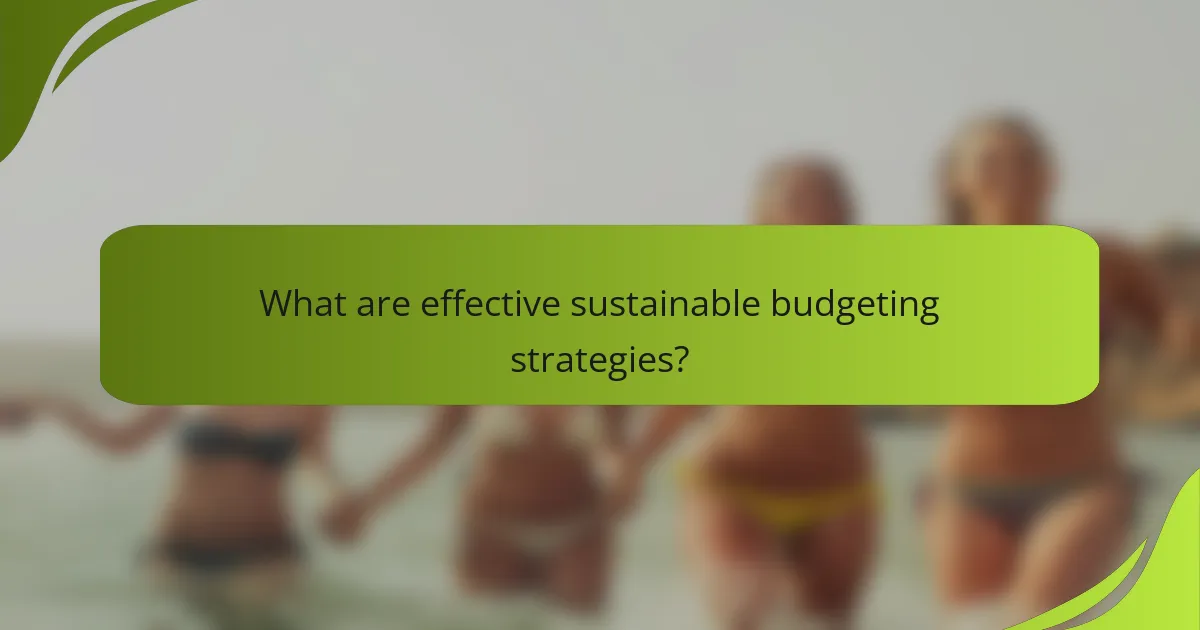
What are effective sustainable budgeting strategies?
Effective sustainable budgeting strategies focus on aligning financial planning with long-term goals while minimizing waste. These methods help individuals and organizations manage their resources efficiently, ensuring that spending reflects priorities and promotes sustainability.
Zero-based budgeting
Zero-based budgeting requires starting from a “zero base” each budgeting period, meaning every expense must be justified anew. This approach encourages careful evaluation of all costs, promoting accountability and resource optimization.
To implement zero-based budgeting, categorize expenses and prioritize them based on necessity. For example, if your monthly budget is $3,000, allocate funds only to essential categories like housing, utilities, and groceries, while justifying any discretionary spending.
Envelope budgeting
Envelope budgeting involves allocating cash for specific spending categories into separate envelopes. Once the cash in an envelope is gone, no more spending is allowed in that category, promoting discipline and awareness of expenditures.
This method is particularly effective for variable expenses like groceries or entertainment. For instance, if you set aside $400 for groceries, once that envelope is empty, you must wait until the next budgeting period to spend more.
50/30/20 rule
The 50/30/20 rule is a simple budgeting framework that divides income into three categories: 50% for needs, 30% for wants, and 20% for savings or debt repayment. This method helps maintain a balanced approach to spending and saving.
For example, if your monthly income is $4,000, allocate $2,000 for necessities, $1,200 for discretionary spending, and $800 for savings or debt. This structure encourages sustainable financial habits while allowing for flexibility.
Incremental budgeting
Incremental budgeting involves adjusting the previous period’s budget based on new information or changes in circumstances. This method is straightforward and often used by organizations to maintain consistency while accounting for inflation or growth.
For instance, if last year’s budget was $10,000 and you expect a 5% increase due to inflation, your new budget would be $10,500. However, be cautious of complacency; ensure that each increment is justified and aligned with your financial goals.
Value-based budgeting
Value-based budgeting focuses on aligning spending with the values and priorities of the individual or organization. This approach encourages evaluating expenses based on their contribution to overall goals rather than merely historical spending patterns.
To apply value-based budgeting, identify your core values, such as sustainability or community support, and allocate funds accordingly. For example, if environmental sustainability is a priority, you might increase your budget for eco-friendly products while reducing spending on less sustainable options.
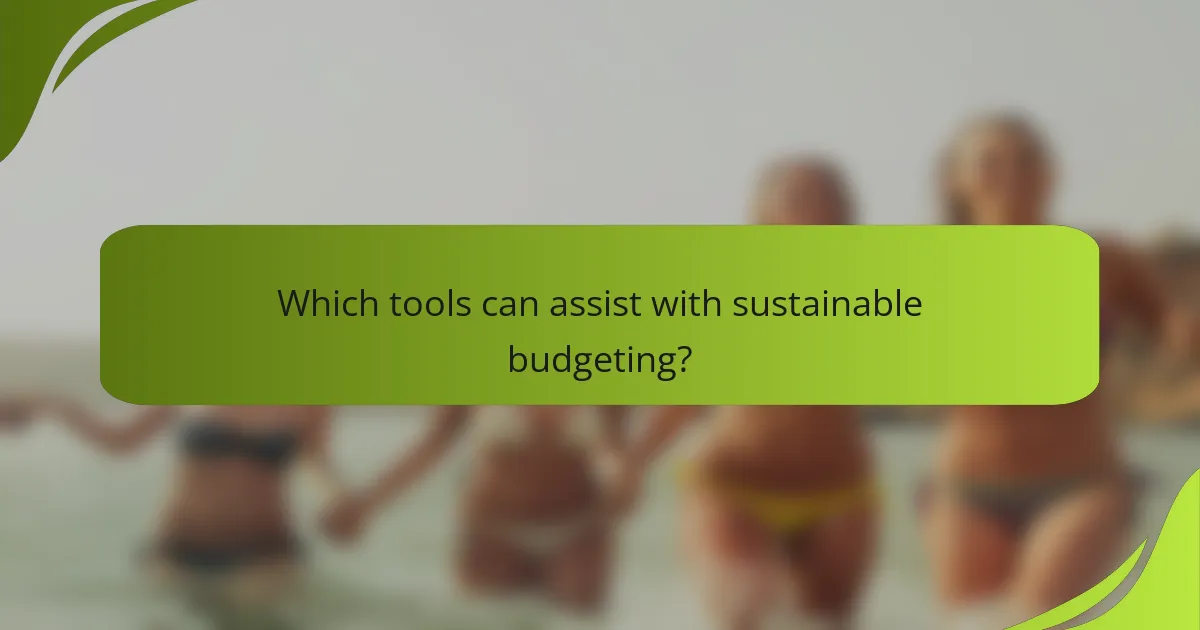
Which tools can assist with sustainable budgeting?
Several tools can help streamline sustainable budgeting by tracking expenses, managing finances, and planning for future investments. These tools provide insights into spending habits and help users allocate resources more effectively.
Mint for expense tracking
Mint is a widely used tool for tracking expenses and managing budgets. It automatically categorizes transactions from linked bank accounts, allowing users to see where their money goes each month. This visibility can help identify areas for cost-cutting and more sustainable spending.
Users can set budget limits for different categories and receive alerts when they approach those limits. Mint also offers features like bill tracking and credit score monitoring, making it a comprehensive financial management tool.
YNAB for proactive budgeting
You Need A Budget (YNAB) is designed for proactive financial planning. It encourages users to allocate every dollar to a specific purpose, which promotes mindful spending and saving. YNAB’s method helps users prioritize their financial goals, making it easier to budget sustainably.
With YNAB, users can adjust their budgets in real-time, ensuring they stay on track throughout the month. The app also provides educational resources to improve budgeting skills, making it suitable for both beginners and experienced budgeters.
EveryDollar for simplicity
EveryDollar is a straightforward budgeting tool that focuses on simplicity and ease of use. Users can create a monthly budget in minutes, dragging and dropping expenses into categories. This simplicity makes it accessible for those new to budgeting.
EveryDollar offers a free version with basic features, while the paid version includes bank syncing for automatic transaction tracking. This can save time and help users maintain a clear overview of their financial situation.
Personal Capital for investment tracking
Personal Capital is ideal for those looking to track investments alongside their budgeting efforts. It provides a comprehensive view of personal finances, including net worth, cash flow, and investment performance. This holistic approach helps users understand how their spending impacts long-term financial goals.
With tools for retirement planning and asset allocation analysis, Personal Capital is particularly useful for individuals focused on building wealth sustainably. Users can also receive personalized advice based on their financial situation, enhancing their investment strategies.
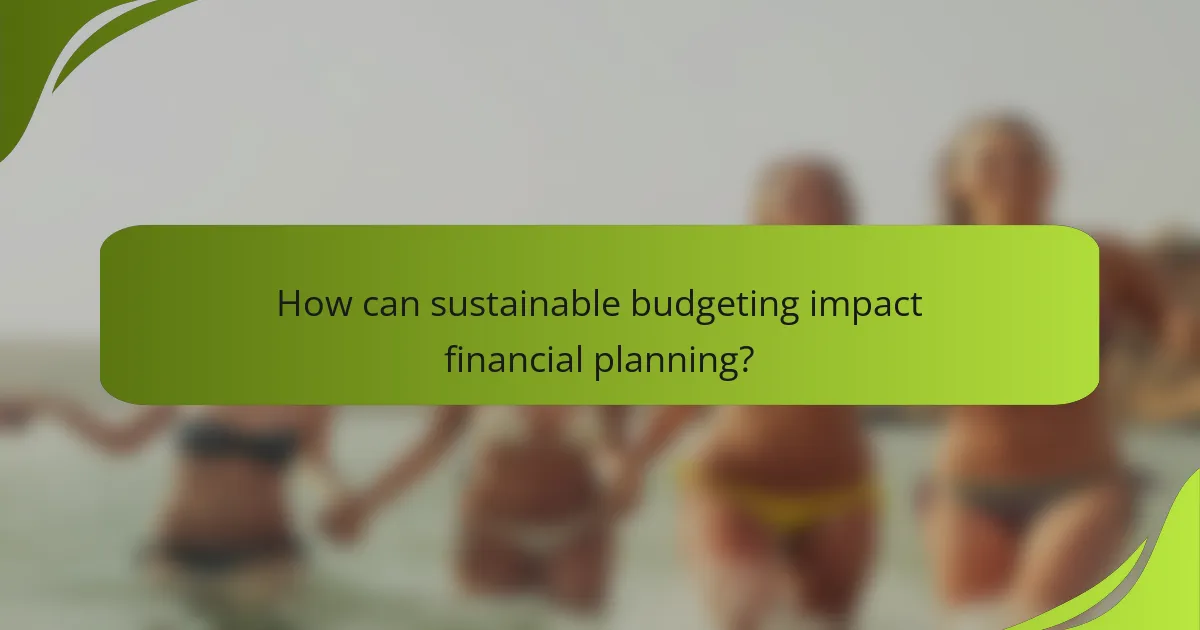
How can sustainable budgeting impact financial planning?
Sustainable budgeting can significantly enhance financial planning by promoting responsible spending and long-term financial health. It encourages individuals and organizations to align their financial decisions with environmental and social goals, ultimately leading to more resilient financial outcomes.
Improved cash flow management
Implementing sustainable budgeting helps in better cash flow management by tracking income and expenses with a focus on sustainability. This approach allows individuals to identify unnecessary expenditures and redirect funds towards eco-friendly initiatives or savings. For instance, reducing energy consumption can lower utility bills, freeing up cash for other priorities.
To effectively manage cash flow, consider using budgeting tools that categorize spending into sustainable and non-sustainable expenses. Regularly reviewing these categories can help maintain a positive cash flow and ensure funds are allocated wisely.
Enhanced financial goal setting
Sustainable budgeting facilitates enhanced financial goal setting by aligning personal or organizational objectives with sustainable practices. By prioritizing goals that promote environmental responsibility, such as investing in renewable energy or sustainable products, individuals can create a more meaningful financial roadmap.
When setting financial goals, consider using the SMART criteria—Specific, Measurable, Achievable, Relevant, and Time-bound. This method ensures that your goals are not only sustainable but also realistic and attainable within a defined timeframe.
Increased savings potential
Adopting a sustainable budgeting approach can lead to increased savings potential by encouraging mindful spending and investment in long-term benefits. By focusing on sustainable options, individuals may find that they save money over time through reduced consumption and lower utility costs.
For example, investing in energy-efficient appliances may have a higher upfront cost but can result in significant savings on energy bills. Additionally, consider setting aside a portion of savings for sustainable investments, which can yield both financial returns and positive environmental impacts.
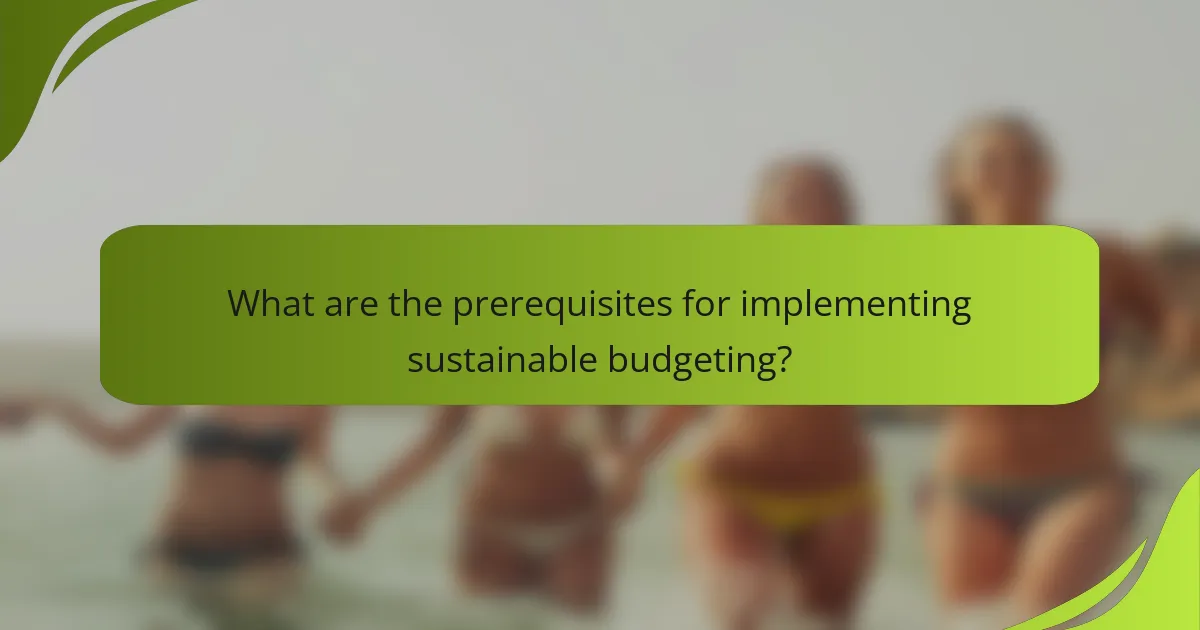
What are the prerequisites for implementing sustainable budgeting?
To successfully implement sustainable budgeting, individuals and organizations must first assess their current financial situation, including income and expenses. Understanding these elements lays the groundwork for making informed decisions that align with sustainability goals.
Understanding income sources
Identifying income sources is crucial for sustainable budgeting. This includes all forms of revenue, such as salaries, investments, and side businesses. Knowing the total income helps in setting realistic budget limits and planning for future expenses.
Consider diversifying income streams to enhance financial stability. For example, in addition to a primary job, one might explore freelance work or passive income opportunities, which can provide additional funds for sustainable initiatives.
Identifying fixed and variable expenses
Fixed expenses are regular payments that remain constant, such as rent or mortgage, utilities, and insurance. Understanding these costs is essential for establishing a baseline budget. Variable expenses, on the other hand, fluctuate monthly and include groceries, entertainment, and discretionary spending.
To create a sustainable budget, categorize expenses into fixed and variable. This allows for better tracking and management. A practical approach is to allocate a specific percentage of income to each category, ensuring that essential costs are covered while leaving room for savings and sustainable investments.

How to choose the right budgeting method for your lifestyle?
Selecting the right budgeting method depends on your financial goals, spending habits, and personal preferences. Consider how much time you can dedicate to budgeting, your income stability, and whether you prefer a structured or flexible approach.
Zero-Based Budgeting
Zero-based budgeting requires you to allocate every dollar of your income to specific expenses, savings, or debt repayment, resulting in a net balance of zero. This method encourages careful tracking of spending and prioritization of needs over wants.
To implement zero-based budgeting, list all sources of income and categorize your expenses. Adjust your budget monthly based on changes in income or expenses. This method works well for those with fluctuating incomes or specific financial goals.
50/30/20 Rule
The 50/30/20 rule divides your after-tax income into three categories: 50% for needs, 30% for wants, and 20% for savings and debt repayment. This straightforward approach simplifies budgeting by providing clear guidelines on how to allocate your income.
To apply this rule, calculate your monthly income and categorize your expenses accordingly. This method is suitable for individuals seeking a balanced approach without extensive tracking, making it easier to maintain over time.
Envelope System
The envelope system involves using cash for different spending categories, placing the allocated amounts into separate envelopes. Once the cash in an envelope is gone, no more spending is allowed in that category for the month.
This method helps control overspending and encourages mindful purchasing. It is particularly effective for discretionary spending categories like dining out or entertainment. However, it may not be practical for all expenses, especially those that require electronic payments.
Digital Budgeting Tools
Digital budgeting tools and apps can streamline the budgeting process by automatically tracking expenses and providing insights into spending habits. Many of these tools sync with your bank accounts, making it easier to monitor your financial health in real-time.
Popular options include Mint, YNAB (You Need A Budget), and PocketGuard. These tools often offer features like goal tracking and reminders, which can enhance your budgeting experience. Choose a tool that aligns with your comfort level and financial objectives.
